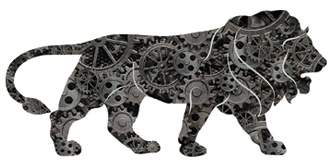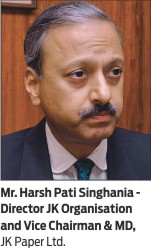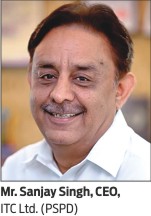 Make in India is a major new national program designed to facilitate investment, foster innovation, enhance skill development, protect intellectual property, and build best-in-class manufacturing infrastructure. With this program India’s manufacturing infrastructure and capacity for innovation are poised for phenomenal growth. New smart cities and industrial clusters are being developed in identified industrial corridors; new youth-focused programs and institutions, dedicated to developing specialized skills, are being considered by the government.
Make in India is a major new national program designed to facilitate investment, foster innovation, enhance skill development, protect intellectual property, and build best-in-class manufacturing infrastructure. With this program India’s manufacturing infrastructure and capacity for innovation are poised for phenomenal growth. New smart cities and industrial clusters are being developed in identified industrial corridors; new youth-focused programs and institutions, dedicated to developing specialized skills, are being considered by the government.
In all these happenings, the important question comes out that what lies in there for the India paper industry. Does the program auger well for Indian paper industry? Paper Mart conducted a series of interviews with the Industry’s stalwarts to know their take on this initiative. The Indian economy set to ride on the high growth trajectory with the new government, the paper industry sounded positive in unison about the fast recovery from the growth slump. Let’s hear what the Industry has to say.
.
 Paper Mart: The Government has launched Make in India campaign to promote manufacturing, do you expect Government coming out with a policy blue print in this regard in the impending budget?
Paper Mart: The Government has launched Make in India campaign to promote manufacturing, do you expect Government coming out with a policy blue print in this regard in the impending budget?
H. P. Singhania: PM’s ‘Make in India’ initiative is seen as an apt vehicle to prop up the manufacturing sector and transform India’s economic future, not only our GDP but most vitally for job creation besides providing a big fillip to exports. But for this there is an urgent need to improve our overall competitiveness and remove the regulatory bottlenecks that undermine business. The govt. has already made some effort in this regard, like moving towards digitization, reduced paper-work, more online, single-window clearance etc., but some stumbling blocks still remain, like the inverted duty structure, uncertainty over taxation regime, inadequate skilled manpower, to name a few. Once these are adequately addressed, investments, whether domestic or overseas, will flow in.
PM: As this would be the first full year budget of Modi Government, what kind of major policy initiatives you expect from the Government?
HPS: The government, since coming to power has already undertaken several initiatives over the last 8-9 months that has helped to improve the overall business climate. But the economic recovery is yet to gain ground. Given that this will be the first full-fledged budget for Modi-led government, it is expected to provide a blueprint of its reform program that should push the Indian economy close to 8 percent growth on sustainable basis. For this there must be a concerted effort to improve upon our ease of doing business and competitiveness for which infrastructure deficiency needs to addressed, particularly by triggering investments in big infrastructure projects like Dedicated Freight Corridors, or other projects in power and road/highway sectors. While investments are key, for new projects to come on-stream, demand revival is of equal importance.
Improvement in physical infrastructure is vital, but with rising literacy and higher aspirations of people it is also very crucial that education levels, in terms of quality and capacity, should be more in sync with employability. The govt. has set a target of 500 million skilled workers in India by 2022, for which there is an urgent need to provide more impetus on skill development programs so that a large pool of young populace gets gainful employment.
To do away with the stringent and multiple tax laws, the govt. is pushing through the GST, but the revenue neutral rate of about 27 percent is too high that could undermine the whole process as compliance will remain poor. We expect some clear picture on this in the budget as well as some reduction in the corporate tax rate of 30 percent as business is much strained by the high incidence of surcharge, enhanced DDT and lowered depreciation rates besides the current high rate of MAT.
PM: This year, Govt. seems to be comfortably meeting fiscal deficit targets largely due to fall in crude prices. What steps you suggest to further bring it down?
HPS: Any shortfall to meet the fiscal deficit target should be ideally met through a more concerted effort towards disinvestment and rationalization of the subsidy bill that ideally should be limited only to the bottom of the pyramid.
PM: On Indirect Tax front, what are your expectations from the Government?
HPS: To promote domestic manufacturing, it is crucial that import of finished products attract duties at least as much, if not more, than what is levied on raw materials. But often this is not the case and certain key industries continue to face the malaise of inverted duty structure. While the interim budget addressed this issue and certain sectors benefitted, the big ones remain out of the ambit. We expect the budget raise import tariffs on finished products like tyre, paper etc., to be on par with their respective key raw material.
PM: What can be the 2-3 lead initiatives that can take lead in boosting growth in Indian economy?
HPS: While more investments, particularly in infrastructure is the need of the hour, but as capacity utilization remains at low ebb, measures must be in place to encourage higher spending and boost growth recovery. For this, it is important to raise individual income tax exemption limits instead of the current guidelines under Section 80C of IT Act. This will bring more money in the hands of the people and therefore encourage more discretionary spending and revive domestic demand. Moreover as manufacturing is still on a gradual recovery mode, it is essential to provide excise benefits to certain industries that has been seriously affected by economic slowdown (e.g., automobiles) or adversely impacted by FTAs (e.g., paper & paper products).
PM: The RBI has started reducing interest rates, what kind of steps Government can take in budget to support this move by RBI?
HPS: The RBI governor has clearly indicated that further rate cuts this year would depend upon the cues provided by the govt. in the form of sticking to fiscal deficit target and address the issue of supply constraints, particularly in food and energy that kept the respective prices high for most of the previous 2-3 years. It is therefore expected that the govt. will not only meet its fiscal deficit target of 4.1 percent of GDP for this financial year but also stick to the medium-term target of 3.6 percent for FY16 and 3 percent the following year. As far as tackling supply-side issues to prevent food inflation spurting again, we expect more concerted steps in the budget regarding price stabilization fund, real-time data to farmers, and move towards a Single ‘National Agricultural Market’. Besides we also expect to see a streamlined approach to warehousing like a cluster-based storage system/ food parks in different parts of the country.
.
 Paper Mart: Will ‘Make in India’ program create an attitudinal shift for the Indian Paper Industry in the eye of investors, government bodies, and the people?
Paper Mart: Will ‘Make in India’ program create an attitudinal shift for the Indian Paper Industry in the eye of investors, government bodies, and the people?
Sanjay Singh: The ‘Make in India’ Program will help the growth of the paper industry in the years to come, as the ease of doing business in India will improve. It will be easier for the paper industry to get the required clearances, including land, and this will increase the growth of pulp and paper in the country.
PM: Will any impetus be given on developing the paper industry under this program?
SS: Discussions are going on with the Central Government and the state governments on the use of degraded forest land for plantations, which will increase the green cover of the country, increase employment, and make available the raw material for the Paper industry.
PM: Under this program, new de-licensing and deregulation measures are being considered for reducing complexity and increasing speed. Will paper industry get benefitted by it?
SS: Since the Government is spending a lot of money on education, greater thrust on development of the paper industry in India will happen, and I expect the Industry to grow at a faster rate in the years to come.
PM: As India is on the course of becoming the fastest growing economy, are we viewed as true partners in the growth, or as just an industry destroying the natural resources?
SS: Paper industry has a negative image of destroying forests, whereas in reality we plant more trees than we cut, and we are working on removing this negative image. Hopefully, in the years to come, people will understand the positive side of the pulp and paper industry, as it is a very sustainable industry providing millions of jobs in the rural areas.
.
 Paper Mart: What’s your take on ‘Make in India’ program. Does the program auger well for Indian paper industry?
Paper Mart: What’s your take on ‘Make in India’ program. Does the program auger well for Indian paper industry?
Saurabh Bangur: “Make in India” campaign is a very broad programme undertaken by GoI to boost/promote investment in India. Undoubtedly, this campaign will boost investment climate and create employment opportunities in the country.
But, going specific to paper sector it is difficult to say whether the sector will benefit out of this campaign. Whether it is “Make in India” campaign or not, in normal sense, for any investment to take place anywhere, market opportunity as well as project viability has to be there for an entrepreneur. Today, paper mills are struggling financially under normal situation only, so talking of fresh investment opportunity is baseless. Average EBIDTA margin of the sector would be around 11-13 percent, whereas ROCE and ROE would be around 5 percent. It is impossible to make investments under these financial ratios.
PM: What according to you, then, is needed to be done in order to boost the paper sector’s growth in the country?
SB: I have mentioned 2 points above, which I would like to mention again for better understanding of the factors needed to be taken care of if we really intend to augment the growth of paper sector in India. First is market opportunity and the second, project viability. If we are able to really grasp the first, we may be able to devise better strategies for the latter. These two things taken care, I’m sure paper industry will come out of growth slump.
PM: Please elaborate on the term market opportunity.
SB: India is a vast country with population base of 120 crores, as per census of 2011. Literacy level which was 63 percent on 103 crores (census base of 2001), has gone up to 74 percent on 120 crores. Clearly, it shows that population base as well as literacy level has increased.
Today, in spite of midday meal schemes and MNREGA program of GoI, 31 percent of population is below the poverty line (i.e., daily income of $1.5 as per World Bank norms). It is estimated that around 2 lakh schools/colleges are needed to cope with population increase and literacy.
With per capita paper consumption of just 10 kg in India against world average of 52 kg, it is needless to mention that there is tremendous scope/potential of the sector to grow in the country.
Moreover, Sarva Shiksha Abhiyan (SSA) Scheme, which has made primary education compulsory for all from age 6-14 years, is estimated to cover approximately 25 crore students. This along with Right to Education scheme has been big booster to education sector in which paper is one of the major constituents of growth. Approximately, USD 20 billion of cumulative allocation has already been made by GoI in these schemes.
To conclude, there is enough potential opportunity in the country which can help the sector to grow in the coming years.
PM: What do you mean when you say ‘project viability’?
SB: It is very unfortunate that inspite of market potential in the region, no green field project has come up in the sector in the last 10-15 years. All the growth has been catered by brown field expansion and imports.
Imports has gone up substantially, in the last 1 year after duty from ASEAN region became NIL from 1st January, 2014. It has forced the domestic producers to lower the price which is one of the reasons of lower margins of paper mills.
A major reason today why paper projects are not viable is non-availability of wood in the country; which is one of the major raw materials for the sector. Today’s Forest Policy does not allow corporates to own large tracts of forest lands to ensure sustainable quality of supply at an affordable rate which mills in ASEAN countries enjoy the benefit of. Eucalyptus wood costs on an average USD 150 per tonne in India, which would be around USD 75 per tonne in South-East Asian countries, leave aside the yield benefits.
Wood is approximately 50 percent of our sales. With this difference it is absolutely impossible for Indian Paper Mills to compete with South-East Asian giants.
To conclude, in order to make projects viable in the country which would in return be lucrative to attract investments, GoI must –
1. Impose safeguard duty on ASEAN nil duty imports which would give breathing opportunity to domestic paper mills, thereby improving bottom line.
2. Make Forest Laws flexible or adapt some other model which would secure paper mills on their raw material (wood) supply – both in quality and in cost. Let Forest Land be owned by the Forest Department only; but if some partnership can be arrived between the two, which can be ‘win-win’ for both the sides.
3. In order to make project viable and compete with South-East Asian paper giants, Interest rate has to be moderated. It is difficult for any project to be set up or continue operation at 13 percent level. Today, project loans and working capital loans are at 13 percent plus level. Global interest rates are at 2 percent level.
PM: It is apparent by your argument that you foresee good days ahead for the Indian paper industry, don’t you?
SB: Paper as a commodity is used both in service sector and manufacturing sector. As India grows both the sectors would be instrumental in its growth. Paper would be used generally all across India’s geography and demography. I feel if GoI can look into the above three points, it will give a big boost to the sector for its growth, giving an opportunity for large scale operation, which in turn will help the country to be self sufficient and create employment opportunities.
.
 Paper Mart: Will Make in India program create an attitudinal shift for the Indian Paper Industry in the eye of investors, government bodies, and the people?
Paper Mart: Will Make in India program create an attitudinal shift for the Indian Paper Industry in the eye of investors, government bodies, and the people?
NG: Indian paper industry’s growing size and prospects for future growth will certainly attract the attention of Investors. However, lack of access to a sustainable raw material base will dampen their enthusiasm. Under these circumstances, domestic paper industry may have to take upon itself the risks and rewards of bridging the gap between future demand and capacity. This may require the Govt. to respond positively to the industry’s oft-repeated requests for allocation of waste lands for tree farming. Hopefully, the Make in India campaign will help the bureaucracy to respond positively to resolve this vital issue.
PM: Will any impetus be given on developing the paper industry under this program?
N Gopalaratnam: Make in India campaign visualizes, inter alia, that domestic manufacturing will be the core and central tenet of the present Govt.’s policies on foreign investments, employment generations etc. I do expect the forthcoming Budget will articulate the Govt.’s intention to support and strengthen the domestic manufacturing sector. Meaningful policy measures including fiscal incentives are expected. Paper industry, of course, will also be a beneficiary of such favorable prescriptions.
PM: Under this program, new de-licensing and deregulation measures are being considered for reducing complexity and increasing speed. Will paper industry get benefited by it?
NG: Paper Industry, as of now, has no major licensing issues. The “Make in India” campaign goes hand-in-hand with improving ease of doing business in India. There are many areas where the domestic manufacturing sector faces undue hurdles and hardships in matters relating to Excise, Customs, Income-Tax, etc. The Industry hopes that there will be a perceptible shift in the way the Govt. and its officers view the domestic manufacturing sector, and provide relief in these areas.
PM: As India is on the course of becoming the fastest growing economy. Are we viewed as true partners in the growth, or as just an industry destroying the natural resources?
NG: The negative image of Paper industry as a destroyer of natural resources is beginning to change. People are beginning to understand that the industry is planting more trees than it fells. Paper industry is an eco-friendly industry providing a product with renewable fibers like, wood, bagasse, straw, etc. besides recycling, recovering, and reusing the used paper. No other Industry can match the credential of sustainability as paper industry does.
Simultaneously, people are also beginning to understand the negative impacts of Internet and electronic media. E-waste is a growing menace and will overtake us soon. Unlike paper, this waste is not bio-degradable and will stay forever. Nor is it recyclable.
Paper Industry thus scores very high on these ‘sustainability’ criteria and has a bright future ahead of it.
PM: Availability of land is an issue for planting forest for paper fiber. Does this program cover these kind of issues to facilitate land acquisitions for paper industry?
NG: One of the favorable benefits, the paper industry expects from the Make in India campaign, is an early resolution of the tree farming on waste lands. I understand, some discussions, are underway, in the Govt. on this subject. Hopefully this will materialize into a tangible program for solving the raw material issue for the paper industry.
.
 Paper Mart: Will Make in India program create an attitudinal shift for the Indian Paper Industry in the eye of investors, government bodies, and the people?
Paper Mart: Will Make in India program create an attitudinal shift for the Indian Paper Industry in the eye of investors, government bodies, and the people?
Ved Krishna: I don’t think so. It might bring in more investment and consolidation if the other infrastructural and systemic issues are improved on.
PM: Will any impetus be given on developing the paper industry under this program?
VK: There are various issues that need to be addressed if paper industry is to really develop in the nation. There are basic issues such as availability of stable raw material and fuel. There are technological issues and there are issues to do with professionalism in the industry.
PM: Under this program, new de-licensing and deregulation measures are being considered for reducing complexity and increasing speed. Will paper industry get benefited by it?
VK: Definitely. Systemic changes shall help and make business much easier.
PM: As India is on the course of becoming the fastest growing economy. Are we viewed as true partners in the growth, or as just an industry destroying the natural resources?
VK: It has to be both. Depends on who is looking at it. The responsibility also rests on us, public and the regulators. We as an industry in general have not been the most responsible barring a few. We need to learn, improve and then project reality.
PM: Availability of land is an issue for planting forest for paper fiber. Does this program cover these kinds of issues to facilitate land acquisitions for paper industry?
VK: I think the key remains allotment of degraded forest land and farm forestry. There is much more that can be done in the area. Land acquisition will not be a viable proposition, but leasing can surely increase the forest cover of the country and provide industries with precious raw material. We, on the other hand, will also need to be responsible towards biodiversity needs of the nation.
.
 Paper Mart: Will Make in India program create an attitudinal shift for the Indian Paper Industry in the eye of investors, government bodies, and the people?
Paper Mart: Will Make in India program create an attitudinal shift for the Indian Paper Industry in the eye of investors, government bodies, and the people?
Pawan Agarwal: I seriously doubt this because Indian paper industry has never been lucrative for the investors. Despite its huge potential for employment generation, both direct and indirect, the Indian paper industry has struggled to strike chord with various government bodies. Moreover, its public image has also got a set back with its being potentially polluting industry. The investors have never found paper industry lucrative because of it being capital intensive in nature. The returns on investment accrue quite slowly. The Indian paper industry is having its own set of problems, mainly fiber scarcity and stringent environmental regulations. This program, at the outset, targets environment friendly industries. So, it will be very hard for the paper industry to get any attention.
PM: Will any impetus be given on developing the paper industry under this program?
PA: I think a big impetus can be given to paper industry in the form of waste land development to generate fiber for future. Government should harness the great potential of this industry for employment generation. This industry has direct link with the infrastructure of the country, especially roads and ports. Good roads and ports mean easy and economical transportation of raw material and finished goods. GoI is going to improve the above two areas of infrastructure under this Make in India program. So, it will have positive impact on the paper industry.
PM: Under this program, new de-licensing and deregulation measures are being considered for reducing complexity and increasing speed. Will paper industry get benefited by it?
PA: I doubt if these are anymore the issues with paper industry. Fast environment clearances could be a big plus for this industry.
PM: As India is on the course of becoming the fastest growing economy. Are we viewed as true partners in the growth, or as just an industry destroying the natural resources?
PA: I think the paper industry has failed to create right perception in the minds of public about its usefulness for the economy and its contribution in the growth of the economy. Growing use of digital mode of communication has also reduced its utility. But, this can change as the downside of the electronic gadgets is now becoming more apparent to the public.
PM: Availability of land is an issue for planting forest for paper fiber. Does this program cover these kinds of issues to facilitate land acquisitions for paper industry?
PA: Definitely not. Land acquisition is a big issue today. Paper industry can only think of partnering with the farmers and land owners to develop social forestry. Land acquisition will be quite difficult.



